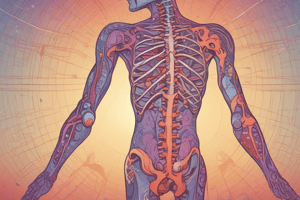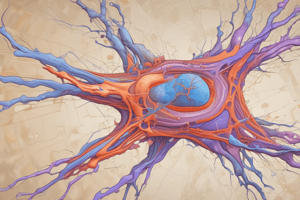Podcast
Questions and Answers
What are the clinical features of rotator cuff tendinopathy?
What are the clinical features of rotator cuff tendinopathy?
Pain with overhead activity, tenderness with palpation over tendon most commonly supraspinatus (+ teres minor tendon), painful arc often between 70-120 degrees.
What are the special tests used for diagnosing rotator cuff tendinopathy?
What are the special tests used for diagnosing rotator cuff tendinopathy?
Impingement tests: Neers, empty/full can, Hawkins Kennedy, apprehension test, ER against resistance (weakness with supraspinatus).
What are the recommended treatments for rotator cuff tendinopathy?
What are the recommended treatments for rotator cuff tendinopathy?
Ice/rest/avoid agg activity, strengthen rotator cuff, progress to eccentric exercises, scapula control exercises, surgery for full thickness tears in younger athletes.
What are the monitoring methods and strategies for promoting adherence to physical activity?
What are the monitoring methods and strategies for promoting adherence to physical activity?
Explain the structural changes that precede knee osteoarthritis (OA) following ACLR.
Explain the structural changes that precede knee osteoarthritis (OA) following ACLR.
What are the contributing factors to structural changes and early onset knee OA following ACLR?
What are the contributing factors to structural changes and early onset knee OA following ACLR?
What are some of the neuro-biomechanical changes post-ACLR that contribute to early onset knee OA?
What are some of the neuro-biomechanical changes post-ACLR that contribute to early onset knee OA?
How are joint forces related to the onset of knee OA following ACLR?
How are joint forces related to the onset of knee OA following ACLR?
What does the evidence show about underloading in both TFJ and PFJ contact forces following ACLR?
What does the evidence show about underloading in both TFJ and PFJ contact forces following ACLR?
What are some strategies for knee OA prevention following ACLR?
What are some strategies for knee OA prevention following ACLR?
What is lacking in terms of evidence for the most effective exercise protocol for back pain?
What is lacking in terms of evidence for the most effective exercise protocol for back pain?
What are the three main domains to assess when evaluating back pain?
What are the three main domains to assess when evaluating back pain?
What is included in the patho-anatomy of back pain?
What is included in the patho-anatomy of back pain?
How is disc degeneration categorized, and does it always present with pain?
How is disc degeneration categorized, and does it always present with pain?
What driver of lower back pain is supported by moderate evidence?
What driver of lower back pain is supported by moderate evidence?
How do emotional responses to pain impact injury and recovery?
How do emotional responses to pain impact injury and recovery?
Explain the difference between peripheral sensitisation and central sensitisation in the context of pain perception.
Explain the difference between peripheral sensitisation and central sensitisation in the context of pain perception.
List the multifactorial nature of low back pain (LBP) as mentioned in the text.
List the multifactorial nature of low back pain (LBP) as mentioned in the text.
Describe the subjective assessment considerations for chronic LBP.
Describe the subjective assessment considerations for chronic LBP.
Explain the movement-based classifications of LBP mentioned in the text.
Explain the movement-based classifications of LBP mentioned in the text.
Define the difference between movement impairment and control impairment in the context of chronic LBP classification.
Define the difference between movement impairment and control impairment in the context of chronic LBP classification.
Discuss the physical assessment methods for chronic LBP mentioned in the text.
Discuss the physical assessment methods for chronic LBP mentioned in the text.
Explain the summary of physiotherapy management of LBP as outlined in the text.
Explain the summary of physiotherapy management of LBP as outlined in the text.
Describe the MDT approach mentioned in the text for managing LBP.
Describe the MDT approach mentioned in the text for managing LBP.
Explain the concept of peripheral pain sensitisation in the context of tissue damage.
Explain the concept of peripheral pain sensitisation in the context of tissue damage.
Discuss the potential causes of SIJ dysfunction and the physical examination for SIJ pain.
Discuss the potential causes of SIJ dysfunction and the physical examination for SIJ pain.
Explain the purpose of SIJ injection in diagnosing SIJ pain.
Explain the purpose of SIJ injection in diagnosing SIJ pain.
Summarize the potential referral criteria for MRI/imaging in the management of LBP.
Summarize the potential referral criteria for MRI/imaging in the management of LBP.
Explain the categories of low back pain presentations mentioned in the text.
Explain the categories of low back pain presentations mentioned in the text.
What are the management strategies for each category of low back pain?
What are the management strategies for each category of low back pain?
What conditions are encompassed by the umbrella term 'spondylarthritis'?
What conditions are encompassed by the umbrella term 'spondylarthritis'?
What are the criteria for diagnosing inflammatory back pain (ankylosing spondylitis) and its clinical manifestations?
What are the criteria for diagnosing inflammatory back pain (ankylosing spondylitis) and its clinical manifestations?
How is ankylosing spondylitis assessed and differentially diagnosed?
How is ankylosing spondylitis assessed and differentially diagnosed?
How are hamstring injuries classified, and what are the types mentioned in the text?
How are hamstring injuries classified, and what are the types mentioned in the text?
What are the prognosis and management options for hamstring tears mentioned in the text?
What are the prognosis and management options for hamstring tears mentioned in the text?
What does the neurological assessment for hamstring pain include?
What does the neurological assessment for hamstring pain include?
What is the mechanism of ACL injury and what are the treatment options mentioned in the text?
What is the mechanism of ACL injury and what are the treatment options mentioned in the text?
What outcomes are mentioned following ACL reconstructions?
What outcomes are mentioned following ACL reconstructions?
What risk is associated with knee osteoarthritis in ACL injury patients 10-15 years post-injury?
What risk is associated with knee osteoarthritis in ACL injury patients 10-15 years post-injury?
What is the importance of muscular strength, endurance, and agility in conservative treatment of ACL injuries?
What is the importance of muscular strength, endurance, and agility in conservative treatment of ACL injuries?
Flashcards are hidden until you start studying
Study Notes
Rheumatology, Spinal Conditions, and Musculoskeletal Injuries Overview
- Categories of low back pain presentations: specific causes, isolated LBP, LBP with limb dominant, and abnormal pain behavior
- Management strategies for each category of low back pain, including referral, therapy, medication, and surgical options
- Spondylarthritis as an umbrella term for conditions like ankylosing spondylitis, reactive arthritis, and psoriatic arthritis
- Criteria for diagnosing inflammatory back pain (ankylosing spondylitis) and its clinical manifestations
- Assessment and differential diagnosis for ankylosing spondylitis, including mechanical back pain and osteitis condensans ilii
- Classification of hamstring injuries into high-speed running and excessive stretching types
- Prognosis and management of hamstring tears, including phases of treatment and specific exercises
- Neurological assessment for hamstring pain, including indications and contraindications for certain tests
- Mechanism of ACL injury and treatment options, including conservative and surgical approaches
- Outcomes following ACL reconstructions, such as thigh muscle strength and knee function
- Increased risk of knee osteoarthritis in ACL injury patients 10-15 years post-injury
- Importance of muscular strength, endurance, and agility in conservative treatment of ACL injuries
Studying That Suits You
Use AI to generate personalized quizzes and flashcards to suit your learning preferences.




